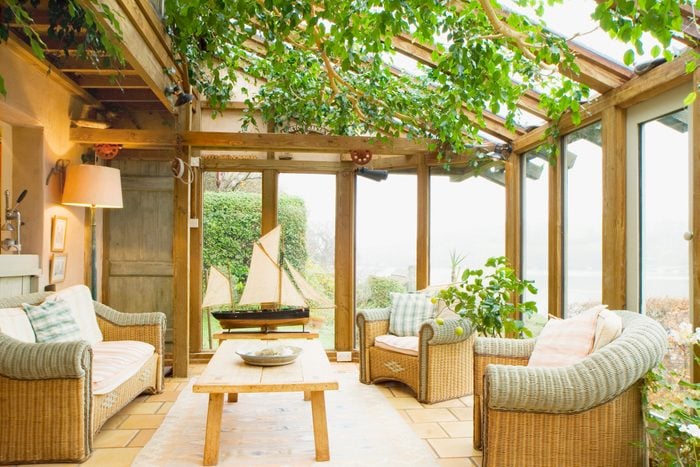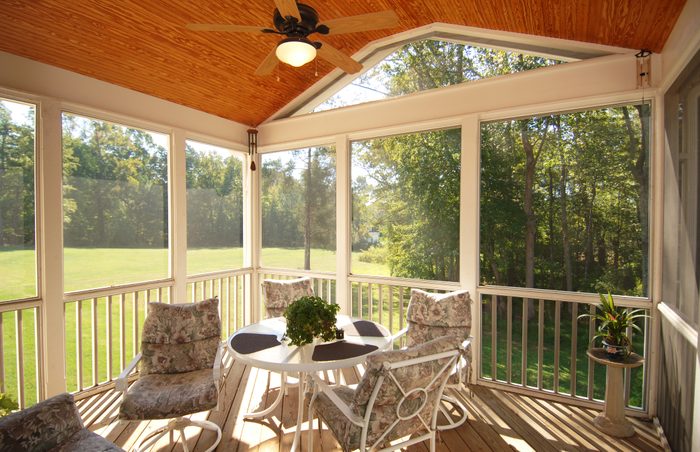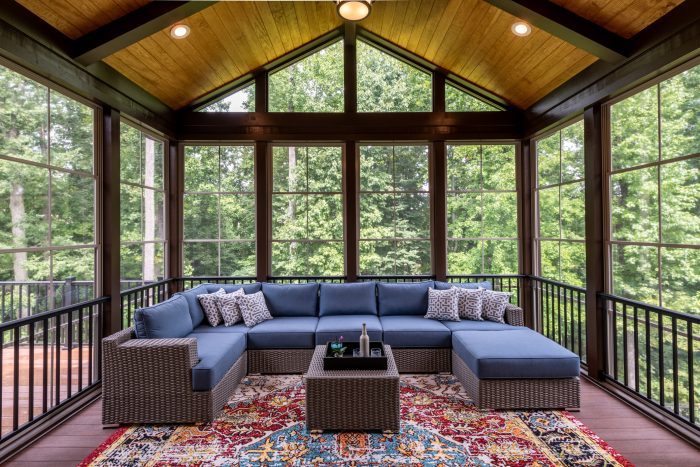Outdoor living spaces featured some of the hottest home improvements of the last few years, and the trend isn’t likely to stop soon. As people spend more time at home, they want a comfortable way to enjoy their outdoor space. But what happens when weather conditions make a patio inhospitable?
An enclosure, such as a sunroom or three-season porch, offers the best of both worlds. Sunlight, outdoor views and fresh air without the bugs, temperature and humidity. Perfect.
Wondering how to choose between a sunroom vs. screened porch? Here’s the scoop.
What Is a Sunroom?

A sunroom is fully enclosed with insulated walls and lots of windows, usually on three sides, and often with skylights. It can be temperature controlled and utilized year-round, even in the dead of winter.
Sunrooms are great for house plants since they let in so much natural light. Sunrooms allow people to enjoy the feeling of being outdoors without the associated heat, cold, humidity, precipitation and pests.
Sunroom vs. Screened Porch
Sunrooms and screened porches differ most in the way they’re constructed and insulated. While screened porches are often simple enclosures built on top of an existing patio or porch, sunrooms are true extensions of the home.
“While a sunroom may be somewhat less insulated than the rest of a house,” says Leonard Ang, CEO of iPropertyManagement, “it’s still sitting on the same foundation, under the same roof, and has essentially the same walls as the rest of the house (with more windows).”
A screened porch doesn’t offer the same level of protection from the elements. Essentially, Ang says, it’s a “porch that has been walled off. It will usually not have a proper floor built over a foundation and will often have little or no insulation.”
Many screened porches have windows or removable panels along with screens. That’s why screened porches are often called three-season porches. They offer enough shelter for fall and spring. But even when the screens are covered, they’re not really usable in really cold winters.
How To Choose Between a Sunroom and a Screened Porch

While the main difference between a sunroom and screened porch is that fourth season, there are other things to consider before building a sunroom addition. The location of your home, goal of the space, permits required, utility cost, usable time and overall construction cost will all factor into your decision.
Location
Although sunrooms seem like the obvious choice for regions with extreme temperatures, they’re not necessarily the most common. Dillon Walker of Screenmobile, a family company founded in 1980 that specializes in windows, doors and enclosures, says screened porches are significantly less expensive to build. That’s why, he says, “three-season rooms are just as popular in those areas.”
In regions with mild winters, a screened porch is just fine for all four seasons. In regions with harsh winters, a sunroom is ideal, but a more affordable screened porch will do.
Goal of the space
If you just want a shaded outdoor space to spend time with friends and family in the summer, fall and spring, a screened porch may be enough. The porch enclosure doesn’t control temperature as well as a sunroom does, but it’s still pretty effective, and there are ways to give it a hand.
Many screened porches have ceiling fans even if they aren’t heated or air conditioned. And a little electric space heater is much less expensive than an outdoor patio heater.
If you want a space to keep house plants year-round, a screened porch isn’t it. A sunroom is the better option for keeping plants — and people — comfortable in the winter.
Return on investment
Consider the cost of a sunroom or screened porch and weigh it against the value you’ll get from it.
How often will you use it? Is having a sunny winter space worth the extra cost of permitting, constructing and heating a sunroom? Will you live in your home long enough to enjoy the sunroom, or do you plan to move? Is a sunroom a highly sought-after feature for potential buyers in your area?
Much like choosing between an above-ground or in-ground pool, the worth of a sunroom or screened porch worth differs with homeowner. And just as a pool doesn’t always increase your home’s value, a sunroom or screened porch isn’t guaranteed to, either.
A sunroom is generally more marketable than a screened porch, And unlike a screen porch, it can be included in your home’s square footage.
Costs of a Screened Porch or Sunroom Addition
Sunrooms are by far the more expensive option. The cost of a sunroom addition varies greatly depending on the square footage, materials used and house specifications. Walker estimates the lowest price would be around $20,000. However, costs add up quickly. Says Ang: “A proper sunroom with full insulation, foundation and roof can run up to $60,000.”
A screened porch will also vary in price, but even the high end of the range is much less than a sunroom. “Typically, it’s between $3,500 and $7,500,” Walker says. If the porch and roof are already in place, Ang says a screened porch “can be built for as little as $2,000.”
Permitting is another cost to keep in mind. Some municipalities require building permits for screening a porch, but you might be off the hook if you’re just adding screens to an existing structure. “Sunrooms have harder permitting because it is basically building a separate room with insulated walls and glass windows,” Walker says.
Building a sunroom addition is much more involved than enclosing a porch. You may need multiple building permits depending on the scope of the project.
Finally, consider the miscellaneous costs after construction is complete. How will you furnish the space? How will it affect your utility bills? A sunroom can have heat, air conditioning, electricity and even plumbing, which Ang recommends for plant lovers to make watering easier.
It might cost more up front to build a sunroom with energy efficient windows. But when the room is basically all windows, the wrong ones can waste a lot of heat — literally throwing money out the window.
What Are Sunroom Kits?
Prefabricated sunroom kits are a more affordable option for experienced DIYers, though they’re lower quality.
These kits have fewer options for customization, and they lack the seamless look and feel of a traditional sunroom addition. They’re simply attached to your home’s exterior wall so the siding is visible from within the sunroom. An existing exterior or patio door usually becomes the entrance to the sunroom.
“Sunroom kits walk the line between a fully-built sunroom and a screen porch,” Ang says. “In general, they have much more in common with screen porches than sunrooms.” Since they’re less likely to be heated or well-insulated, many sunroom kits are best suited as three-season rooms.
Walker advises caution when ordering a DIY sunroom kit. “Unless you know exactly what you’re dealing with, you may get something you didn’t want — and lots of gray hairs along the way,” he says. Consulting with a professional will help you find the right fit, whether that be a fully-built sunroom, a screened porch or a sunroom kit.
Read more: familyhandyman.com
